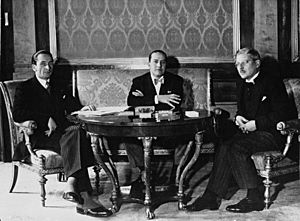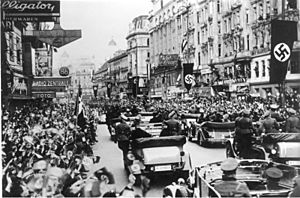Kurt Schuschnigg facts for kids
Quick facts for kids
Kurt Schuschnigg
|
|
|---|---|

Schuschnigg in 1936
|
|
| Chancellor of Austria | |
| In office 29 July 1934 – 11 March 1938 |
|
| President | Wilhelm Miklas |
| Vice-Chancellor | Ernst Rüdiger Starhemberg Eduard Baar-Baarenfels Ludwig Hülgerth Edmund Glaise-Horstenau |
| Preceded by | Engelbert Dollfuss |
| Succeeded by | Arthur Seyss-Inquart |
| Minister of Defence | |
| In office 29 July 1934 – 11 March 1938 |
|
| Preceded by | Ernst Rüdiger Starhemberg |
| Succeeded by | Arthur Seyss-Inquart |
| Minister of Education | |
| In office 24 May 1933 – 14 May 1936 |
|
| Preceded by | Anton Rintelen |
| Succeeded by | Hans Pernter |
| Minister of Justice | |
| In office 29 January 1932 – 10 July 1934 |
|
| Preceded by | Hans Schürff |
| Succeeded by | Egon Berger-Waldenegg |
| Personal details | |
| Born |
Kurt Alois Josef Johann Edler von Schuschnigg
14 December 1897 Reiff am Gartsee, County of Tyrol, Austria-Hungary |
| Died | 18 November 1977 (aged 79) Mutters, Tyrol, Austria |
| Political party | Fatherland Front (1933–1938) |
| Other political affiliations |
Christian Social Party (1927–1933) |
| Spouses |
Herma Masera
(m. 1926; died 1935)Vera Fugger von Babenhausen
(m. 1938; died 1959) |
| Children | Kurt von Schuschnigg Jr. Maria Dolores Edle von Schuschnigg |
| Parents | Artur von Schuschnigg Anna Josefa Amalia Wopfner |
| Alma mater | University of Freiburg Innsbruck University |
| Military service | |
| Allegiance | |
| Branch/service | |
| Years of service | 1915–1919 |
| Battles/wars | World War I
|
Kurt Alois Josef Johann von Schuschnigg (born December 14, 1897 – died November 18, 1977) was an important Austrian politician. He served as the Chancellor of Austria from 1934 until 1938. He became Chancellor after his predecessor, Engelbert Dollfuss, was killed.
Schuschnigg was strongly against Adolf Hitler's plan to take over Austria and make it part of Nazi Germany. He wanted Austria to stay an independent country. When his efforts to keep Austria free failed, he resigned. After Austria was taken over in 1938, he was arrested and held in different concentration camps. He was freed in 1945 by the United States Army. After the war, he moved to the United States and became a professor.
Contents
Biography
Early Life and Education
Kurt Schuschnigg was born in a place called Reiff am Gartsee (now Riva del Garda) in what was then the County of Tyrol in Austria-Hungary. His father, Artur von Schuschnigg, was an Austrian General. His family had a long history of military service.
He went to a Jesuit school called Stella Matutina. During World War I, he was captured on the Italian Front and was a prisoner until 1919. After the war, he studied law at the University of Freiburg and the University of Innsbruck. He became a lawyer in Innsbruck in 1922.
Political Career in Austria
Schuschnigg started his political journey by joining the Christian Social Party. In 1927, he was elected to the Nationalrat, which is like Austria's parliament. He was the youngest member at the time.
In 1932, he became the Minister of Justice. The next year, in 1933, he also became the Minister of Education. As Justice Minister, he supported changes that reduced the power of the parliament and brought back the death penalty. In 1933, he and Chancellor Dollfuss dissolved the parliament. After a workers' uprising in 1934, he ordered the execution of some of the rebels. He later said this was a mistake.
On May 1, 1934, Chancellor Dollfuss created a new, more authoritarian government in Austria. After Dollfuss was assassinated in July 1934, Schuschnigg became the new Austrian Chancellor. Like Dollfuss, he often ruled by special orders instead of through parliament.
Schuschnigg faced many challenges. Austria's economy was struggling, and he had to keep order in a country that was not allowed to have a large army. He also had to deal with armed groups loyal to different political parties. Most importantly, he had to manage the growing power of the Austrian Nazis, who wanted Austria to join Nazi Germany. His main goal was to keep Austria independent.

Schuschnigg tried to get support from Italy and Hungary to balance the threat from Germany. However, Italy's leader, Benito Mussolini, started to support Hitler, which left Austria more vulnerable. Schuschnigg tried to make peace with Hitler, even calling Austria the "better German state," but he still wanted Austria to be independent. In 1936, he signed an agreement with Germany that allowed some imprisoned Nazis to be released and included some pro-Nazi officials in his government. The Nazi Party was still banned, but their influence in Austria grew.
There are also rumors that Schuschnigg helped the famous Von Trapp family become well-known. It's said he heard them sing on the radio and invited them to perform in Vienna, which helped them gain fame.
The Anschluss (Takeover)
On February 12, 1938, Schuschnigg met Hitler at his home in Germany. Schuschnigg hoped to improve relations, but Hitler gave him a list of demands that were like an ultimatum. Hitler demanded that Austrian Nazis be given important government positions, including Arthur Seyss-Inquart as security minister (who controlled the police) and Hans Fischböck as finance minister. Hitler also wanted German and Austrian armies to exchange officers and all imprisoned Nazis to be freed. In return, Hitler promised to respect Austria's independence. Schuschnigg felt forced to sign this agreement.
Austria's President, Wilhelm Miklas, was hesitant but eventually agreed. Schuschnigg then tried to reorganize his government to include members from different political groups. However, Hitler quickly appointed a new Nazi leader for Austria.
On February 20, Hitler gave a speech that was broadcast in Austria. He said that Germany would no longer tolerate the "suppression of ten million Germans across its borders," referring to Austrians. This caused concern and protests in Austria.
Schuschnigg gave an emotional speech to the Austrian parliament, saying, "Austria will go thus far and no further." He ended with a patriotic cry: "Red-White-Red (the colors of the Austrian flag) until we're dead!" This speech angered the Austrian Nazis, who began to organize their supporters.
To show Hitler and the world that Austrians wanted to remain independent, Schuschnigg decided to hold a public vote (a plebiscite) on March 13. However, the question for the vote was complicated, and it excluded most young people under 24 from voting. This was a problem because many young people supported the Nazis.
Schuschnigg tried to get support from the Social Democrats by promising to make their party legal again. But Germany reacted quickly. Hitler demanded the plebiscite be canceled and that Schuschnigg resign, insisting that Seyss-Inquart become the new Chancellor. President Miklas was reluctant but eventually agreed under the threat of German invasion. Schuschnigg resigned on March 11, 1938. German troops then entered Austria and were met by many cheering crowds. On March 12, Schuschnigg was placed under house arrest.
Prison and Later Life
After being held under house arrest and then in solitary confinement, Kurt Schuschnigg spent all of World War II in concentration camps, first in Sachsenhausen and then in Dachau. In April 1945, he narrowly escaped being executed by Hitler's orders. He and other important prisoners were moved to South Tyrol, where their guards abandoned them. They were then freed by German army officers and later handed over to American troops on May 4, 1945.
After the war, Schuschnigg moved to the United States. He became a professor of political science at Saint Louis University from 1948 to 1967. His second wife, Vera, passed away in 1959. His first wife had died in a car accident in 1935. Kurt Schuschnigg died in Mutters, Austria, in 1977.
Works
- My Austria (1937)
- Austrian Requiem (1946)
- International Law (1959)
- The Brutal Takeover (1969)
See also
 In Spanish: Kurt Schuschnigg para niños
In Spanish: Kurt Schuschnigg para niños
Images for kids



